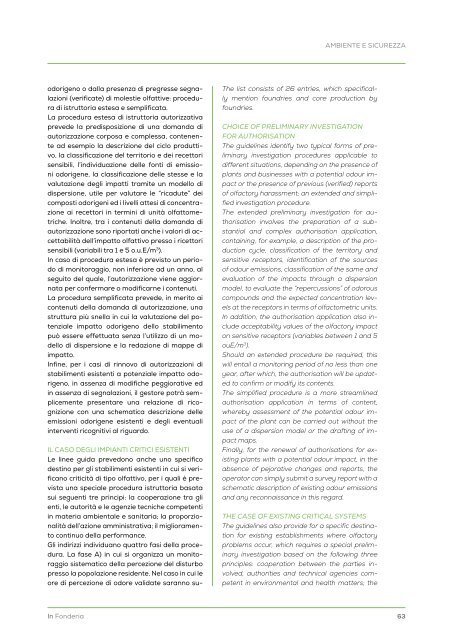In Fonderia 1 2024
Primo numero del 2024 di In Fonderia
Primo numero del 2024 di In Fonderia
You also want an ePaper? Increase the reach of your titles
YUMPU automatically turns print PDFs into web optimized ePapers that Google loves.
AMBIENTE E SICUREZZA<br />
odorigeno o dalla presenza di pregresse segnalazioni<br />
(verificate) di molestie olfattive: procedura<br />
di istruttoria estesa e semplificata.<br />
La procedura estesa di istruttoria autorizzativa<br />
prevede la predisposizione di una domanda di<br />
autorizzazione corposa e complessa, contenente<br />
ad esempio la descrizione del ciclo produttivo,<br />
la classificazione del territorio e dei recettori<br />
sensibili, l’individuazione delle fonti di emissioni<br />
odorigene, la classificazione delle stesse e la<br />
valutazione degli impatti tramite un modello di<br />
dispersione, utile per valutare le “ricadute” dei<br />
composti odorigeni ed i livelli attesi di concentrazione<br />
ai recettori in termini di unità olfattometriche.<br />
<strong>In</strong>oltre, tra i contenuti della domanda di<br />
autorizzazione sono riportati anche i valori di accettabilità<br />
dell’impatto olfattivo presso i ricettori<br />
sensibili (variabili tra 1 e 5 o.u.E/m 3 ).<br />
<strong>In</strong> caso di procedura estesa è previsto un periodo<br />
di monitoraggio, non inferiore ad un anno, al<br />
seguito del quale, l’autorizzazione viene aggiornata<br />
per confermare o modificarne i contenuti.<br />
La procedura semplificata prevede, in merito ai<br />
contenuti della domanda di autorizzazione, una<br />
struttura più snella in cui la valutazione del potenziale<br />
impatto odorigeno dello stabilimento<br />
può essere effettuata senza l’utilizzo di un modello<br />
di dispersione e la redazione di mappe di<br />
impatto.<br />
<strong>In</strong>fine, per i casi di rinnovo di autorizzazioni di<br />
stabilimenti esistenti a potenziale impatto odorigeno,<br />
in assenza di modifiche peggiorative ed<br />
in assenza di segnalazioni, il gestore potrà semplicemente<br />
presentare una relazione di ricognizione<br />
con una schematica descrizione delle<br />
emissioni odorigene esistenti e degli eventuali<br />
interventi ricognitivi al riguardo.<br />
IL CASO DEGLI IMPIANTI CRITICI ESISTENTI<br />
Le linee guida prevedono anche uno specifico<br />
destino per gli stabilimenti esistenti in cui si verificano<br />
criticità di tipo olfattivo, per i quali è prevista<br />
una speciale procedura istruttoria basata<br />
sui seguenti tre principi: la cooperazione tra gli<br />
enti, le autorità e le agenzie tecniche competenti<br />
in materia ambientale e sanitaria; la proporzionalità<br />
dell’azione amministrativa; il miglioramento<br />
continuo della performance.<br />
Gli indirizzi individuano quattro fasi della procedura.<br />
La fase A) in cui si organizza un monitoraggio<br />
sistematico della percezione del disturbo<br />
presso la popolazione residente. Nel caso in cui le<br />
ore di percezione di odore validate saranno su-<br />
The list consists of 26 entries, which specifically<br />
mention foundries and core production by<br />
foundries.<br />
CHOICE OF PRELIMINARY INVESTIGATION<br />
FOR AUTHORISATION<br />
The guidelines identify two typical forms of preliminary<br />
investigation procedures applicable to<br />
different situations, depending on the presence of<br />
plants and businesses with a potential odour impact<br />
or the presence of previous (verified) reports<br />
of olfactory harassment: an extended and simplified<br />
investigation procedure.<br />
The extended preliminary investigation for authorisation<br />
involves the preparation of a substantial<br />
and complex authorisation application,<br />
containing, for example, a description of the production<br />
cycle, classification of the territory and<br />
sensitive receptors, identification of the sources<br />
of odour emissions, classification of the same and<br />
evaluation of the impacts through a dispersion<br />
model, to evaluate the “repercussions” of odorous<br />
compounds and the expected concentration levels<br />
at the receptors in terms of olfactometric units.<br />
<strong>In</strong> addition, the authorisation application also include<br />
acceptability values of the olfactory impact<br />
on sensitive receptors (variables between 1 and 5<br />
ouE/m 3 ).<br />
Should an extended procedure be required, this<br />
will entail a monitoring period of no less than one<br />
year, after which, the authorisation will be updated<br />
to confirm or modify its contents.<br />
The simplified procedure is a more streamlined<br />
authorisation application in terms of content,<br />
whereby assessment of the potential odour impact<br />
of the plant can be carried out without the<br />
use of a dispersion model or the drafting of impact<br />
maps.<br />
Finally, for the renewal of authorisations for existing<br />
plants with a potential odour impact, in the<br />
absence of pejorative changes and reports, the<br />
operator can simply submit a survey report with a<br />
schematic description of existing odour emissions<br />
and any reconnaissance in this regard.<br />
THE CASE OF EXISTING CRITICAL SYSTEMS<br />
The guidelines also provide for a specific destination<br />
for existing establishments where olfactory<br />
problems occur, which requires a special preliminary<br />
investigation based on the following three<br />
principles: cooperation between the parties involved,<br />
authorities and technical agencies competent<br />
in environmental and health matters; the<br />
<strong>In</strong> <strong>Fonderia</strong><br />
63














